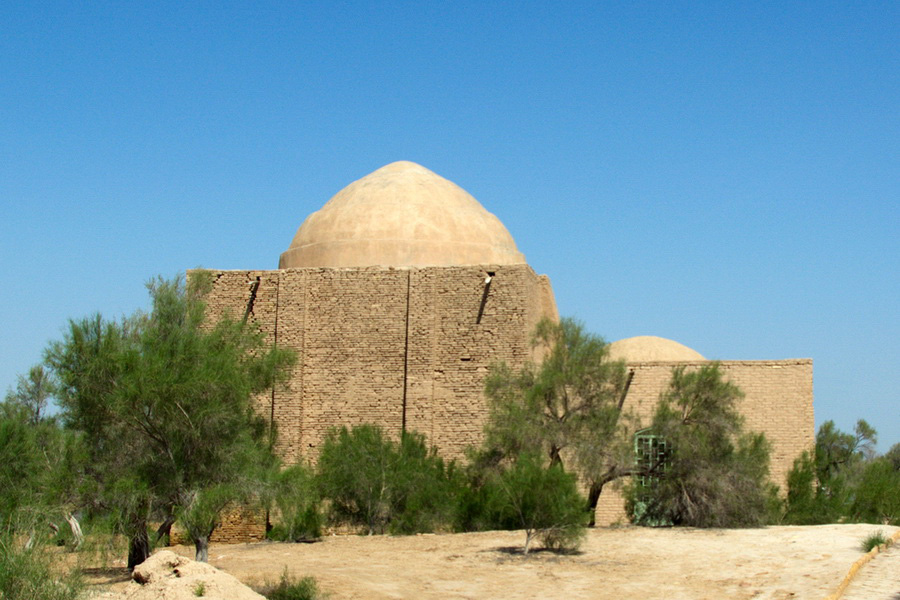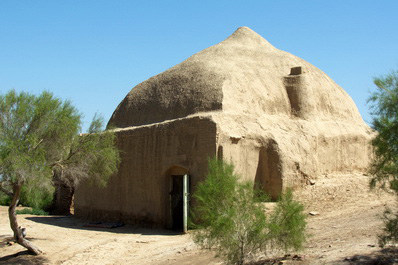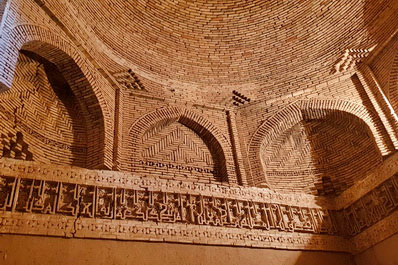Muhammad ibn-Zeid Mausoleum, Merv

The Mausoleum of Muhammad ibn Zeid (Muhammad ibn Zayd) is an original architectural monument from the early 11th century, located west of Sultan Kala (Sultan Qala) in Ancient Merv. It was built over the burial site of Muḥammad ibn al-Ḥanafiyyah (Muhammad-Sayyid ibn-Zeid), who led a revolt against the Umayyad dynasty of Arab caliphs. Muhammad ibn Zeid lived in the 8th century and was the son of Ali ibn Abu Talib Hazrat Ali Murtaza, a cousin and son-in-law of the Prophet Muhammad, and his second wife, Hanafiyyah. Among Muhammad ibn Zeid’s descendants is the famed Islamic preacher, Khoja Ahmed Yasawi.
The mausoleum was constructed in 1112 by order of Sharaf-al-Din Abu Tahir, the ruler of Merv, nearly three centuries after Muhammad ibn Zeid’s execution. Initially, it was a modest structure made of raw bricks with walls measuring 8.5 meters. Over time, the mausoleum expanded into an architectural complex, with an additional mausoleum (mazar) and a memorial mosque built alongside it. The structure has undergone several reconstructions, but the dome and brickwork, both inside and outside, have been well preserved.
The mausoleum, which dates back to the same period as the famous Mausoleum of Sultan Sanjar, has survived remarkably well. Archaeologists, after removing walls from previous restorations, were able to appreciate the craftsmanship of the original architects, especially the brickwork, arches, mazar, and mosque, which are all covered with domes. Nearby, researchers discovered a reservoir with a deep excavation, though it no longer holds water and lacks its original cover.
The entrance to the mausoleum is designed as an arch adorned with decorative brickwork, and the structure is crowned by a dome - characteristic of the architectural style of Khorasan. Inside, the same intricate brick and gypsum decoration extends to the walls and the under-dome ornaments, shaped like sails.
Beneath the “sails” is an epitaph, which was deciphered by the renowned archaeologist Mikhail Masson: "Here rests the head of Imam Muhammad-Sayyid ibn-Zeid, a representative of Shiite Islam. This mausoleum was erected by order of Sharaf-al-Din Abu Tahir, the ruler of Merv".
Even the mihrab (a niche in the wall indicating the direction of Mecca) has been preserved, featuring an unusual twelve-petal design. The mausoleum is surrounded by greenery, and just opposite the entrance is a tamarisk bush, considered sacred and adorned with brightly colored pieces of cloth.
The Mausoleum of Muhammad ibn Zeid is recognized as an outstanding example of Islamic architecture. A visit to this mausoleum, located in Ancient Merv, is a must to truly appreciate the former beauty and grandeur of the old city.


